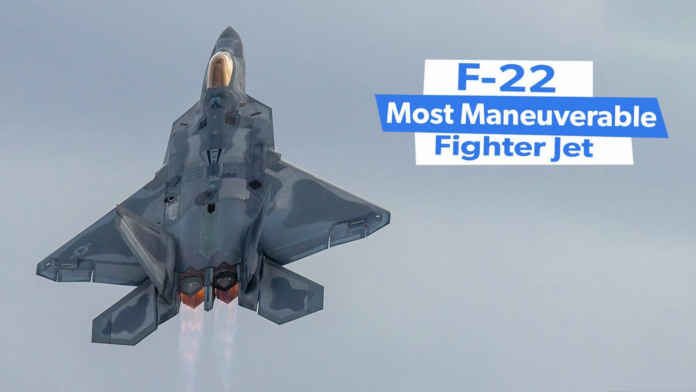The F-22 is a highly capable and maneuverable fighter and a critical component the Global Strike Task Force. This aircraft is purpose-built to project air dominance both rapidly and at great distances, in order to defeat threats attempting to impede access to the US military.
What gives the F-22 is excellent maneuverability? The answer lies with its thrust vectoring capabilities.
A synopsis of the F22s history
The F-22 program began in the early 1980s, with the purpose of developing an advanced and highly-capable successor to the F-15. This program was given Milestone I approval in October 1986 and the first flight of an F-22 prototype got off the ground in August 1990.
By August 2001, the program was granted approval for Low Rate Initial Production (LRIP), the first LRIP F-22 was delivered in June 2003. Finally, in December 2005, the F-22 program achieved Initial Operating Capability in December 2005.
Photo: Aditya0635 | Shutterstock
The use of the thrust vectoring nozzles as a supplementary control surface allows an aircraft to greatly enhance its angle of attack… ✕ Remove Ads
In sum, 195 F-22s were produced and delivered, this includes nine test variants. Unfortunately, the last production model of this amazing aircraft was delivered in 2012. The USAF plans on operating the F-22 until 2040 or beyond.
Photo: Lockheed Martin
According to the Defense Acquisition Encyclopedia , “ The Initial Operational Capability (IOC) is a point in time during the Production & Deployment…Phase where a system can meet the minimum operational…capabilities for a user’s stated need…IOC is a good gauging point to see if there are any refinements needs before proceeding to Full Operational Capability…”
Information table for the F-22
General Characteristics Information Primary function Air dominance, multi-role fighter Contractor Lockheed-Martin, Boeing Power plant Two Pratt & Whitney F119-PW-100 turbofan engines with afterburners and two-dimensional thrust vectoring nozzles Thrust 35,000-pound class (each engine) Wingspan 44 feet, 6 inches (13.6 meters) Length 62 feet, 1 inch (18.9 meters) Height 16 feet, 8 inches (5.1 meters) Weight: 43,340 pounds (19,700 kilograms) Maximum takeoff weight 83,500 pounds (38,000 kilograms) Fuel capacity Internal: 18,000 pounds (8,200 kilograms); with 2 external wing fuel tanks: 26,000 pounds (11,900 kilograms) Speed Mach two class with supercruise capability Range More than 1,850 miles ferry range with two external wing fuel tanks (1,600 nautical miles) Ceiling Above 50,000 feet (15 kilometers) Crew 1 Unit cost $143 million
The key to the F-22s amazing maneuverability
According to the US Air Force:
“The key to the F-22’s ability to maneuver better than conventional fighters is a system called thrust vectoring. Thrust vectoring is controlled by the pilot through the flight controls and gets the F-22 quickly from one maneuver to another.”
Photo: Pratt & Whitney
The thrust vectoring nozzles on the two engines are controlled by the same flight control system that maintains operation of the horizontal tails, rudders and the wing surfaces. Thus, when the pilot moves in a desired direction, the nozzles move automatically and in tandem with the elevator, rudder and aileron control surfaces. What’s more, the nozzles are capable of being moved up or down 20 degrees by the pilot.
Photo: USAF
The use of the thrust vectoring nozzles as a supplementary control surface allows an aircraft to greatly enhance its angle of attack in stationary, level flight, for a given flight point and load configuration. This reduces drag, which then leads to increased benefits in Specific Fuel Consumption and, therefore, range.
Photo: Lockheed Martin
One of the greatest benefits of thrust vectoring is the fact that it can maintain active control of an aircraft while the primary aerodynamic surfaces are stalled, thus not suitable for control. This post-stall control is where the F-22 maintains an exceptional edge over fighters with conventional thrust nozzles.
Thrust vectoring and air superiority
Thrust vectoring allows for better control of an aircraft, particularly at low-speed conditions. This is where conventional aerodynamic controls are not effective. Additionally, these speed conditions are where many combat scenarios are likely to occur.
Photo: NASA
To this point, NASA’s Enhanced Fighter Maneuverability program in the early 1990s, vividly demonstrated the great advantage of thrust vectoring, and its advantage over conventional control.
F-22s conducted its first combat sorties Syria in 2014…
The aircraft in these test flights and simulations was the X31, with vectored thrust. For the purpose of close-in combat simulations, the X31 was pitted against an F-18. The results were staggering, the X31 had a 91%-win ratio, while F-18 managed a 3%-win ration with a 6% neutral outcome.
F-22 and how its currently deployed
Given the limited numbers of the F-22, it is generally reserved for homeland defense missions and deterrence missions abroad. The first homeland defense mission for the F-22 was in 2007 when one intercepted a Russian bomber.
Photo: North American Aerospace Defense Command (NORAD)
The F-22 has been deployed frequently to the Middle East since 2009. Its first combat sorties were conducted in Syria in 2014 and later used during the February 2018 Battle of Kasham to halt Syrian troops and fighters from the Russian PMC, Wagner Group. Ironically, the F-22’s only air-to-air kill occurred on February 4, 2023, when an F-22 from the 1st Fighter Wing shot down a Chinese spy balloon off of South Carolina.
The incredible F-22
The F-22 is the USAFs top fighter aircraft with unsurpassed maneuverability. USAF pilots have described flying it as feeling they are ‘cheating’ as it is so responsive and agile compared to other fourth-generation fighters.
Photo: USAF
With its advanced maneuverability, sensors and other advanced technologies within it, the F-22 has proven its value for deterrence abroad and as a highly capable homeland defense asset. With any hope, these amazing aircraft will fly further into future service with the USAF.



